display MERCEDES-BENZ G-Class 2009 W463 Owner's Manual
[x] Cancel search | Manufacturer: MERCEDES-BENZ, Model Year: 2009, Model line: G-Class, Model: MERCEDES-BENZ G-Class 2009 W463Pages: 264, PDF Size: 6.98 MB
Page 28 of 264
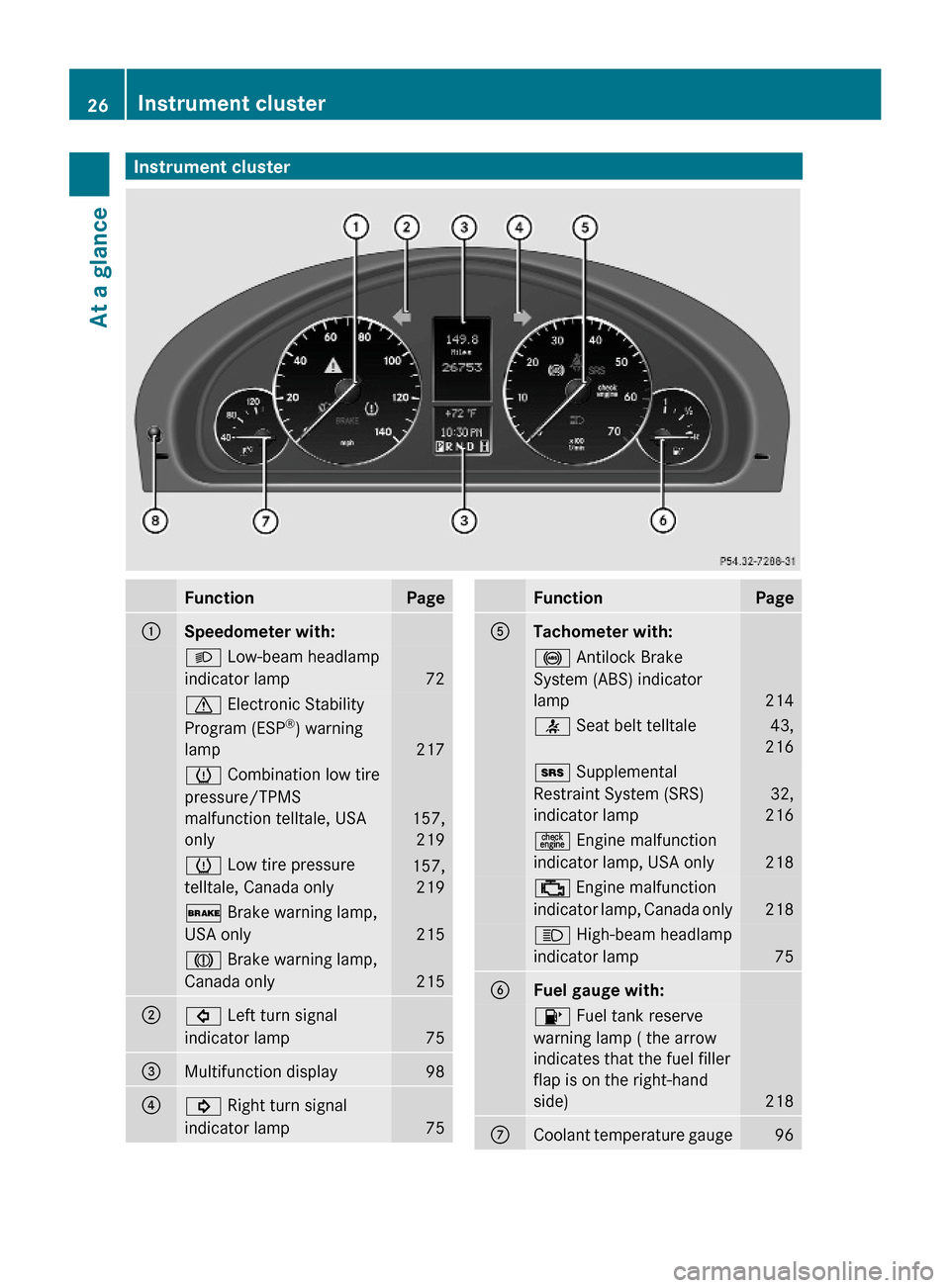
Instrument clusterFunctionPage:Speedometer with:L Low-beam headlamp
indicator lamp72
d Electronic Stability
Program (ESP®) warning
lamp 217
h Combination low tire
pressure/TPMS
malfunction telltale, USA
only
157,
219
h Low tire pressure
telltale, Canada only
157,
219
$ Brake warning lamp,
USA only215
J Brake warning lamp,
Canada only215
;# Left turn signal
indicator lamp 75
=Multifunction display98?! Right turn signal
indicator lamp75
FunctionPageATachometer with: ! Antilock Brake
System (ABS) indicator
lamp 214
7 Seat belt telltale43,
216
+ Supplemental
Restraint System (SRS)
indicator lamp
32,
216
= Engine malfunction
indicator lamp, USA only 218
; Engine malfunction
indicator lamp, Canada only218
K High-beam headlamp
indicator lamp75
BFuel gauge with:8 Fuel tank reserve
warning lamp ( the arrow
indicates that the fuel filler
flap is on the right-hand
side) 218
CCoolant temperature gauge9626Instrument clusterAt a glance
463_AKB; 2; 52, en-USd2ureepe,Version: 2.11.7.12008-12-02T10:52:11+01:00 - Seite 26
Page 29 of 264
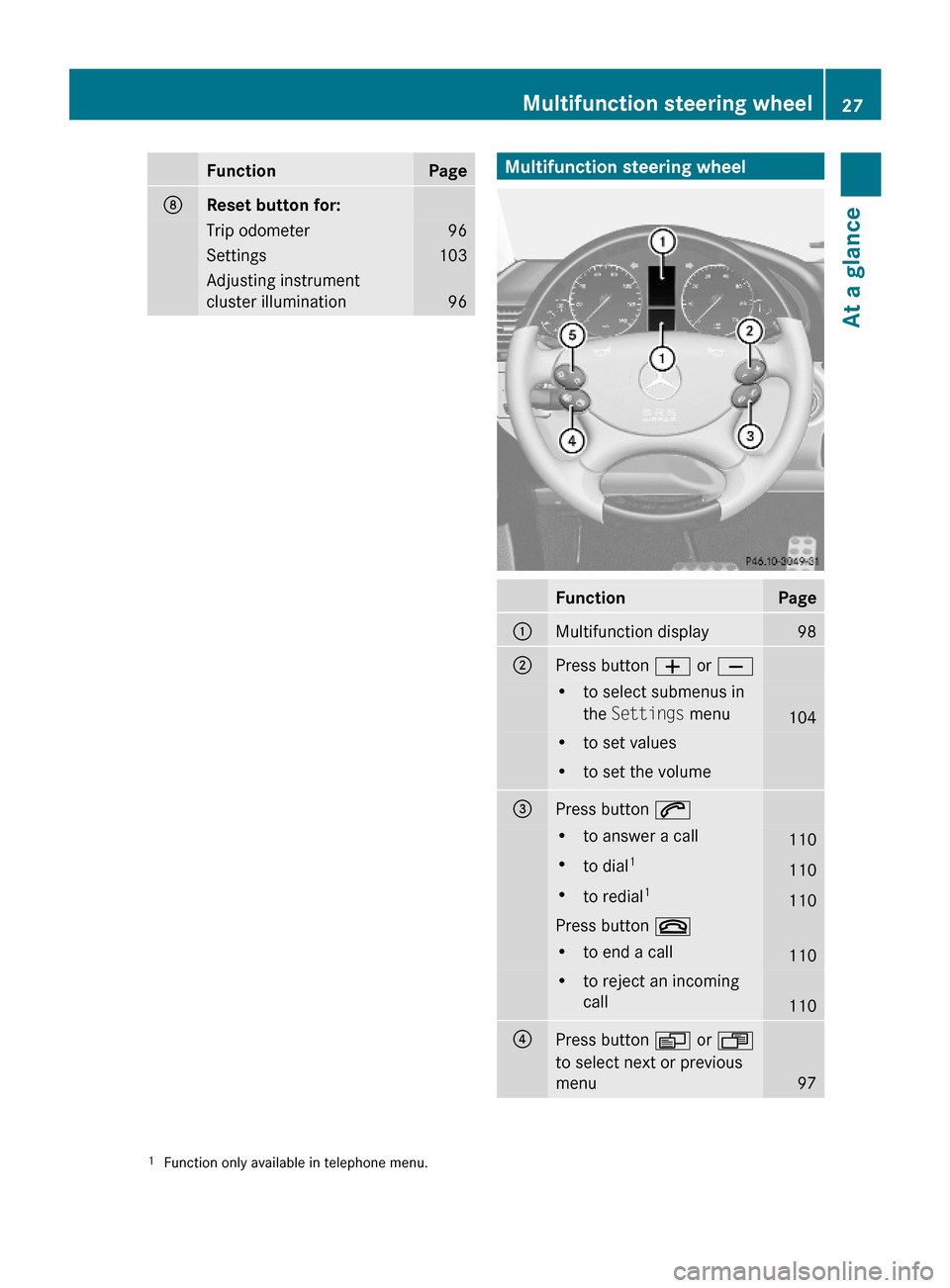
FunctionPageDReset button for: Trip odometer96Settings103Adjusting instrument
cluster illumination96Multifunction steering wheelFunctionPage:Multifunction display98;Press button W or X•to select submenus in
the Settings menu104
•to set values•to set the volume=Press button 6•to answer a call110•to dial1110•to redial1110Press button ~•to end a call110•to reject an incoming
call110
?Press button V or U
to select next or previous
menu97
1Function only available in telephone menu.Multifunction steering wheel27At a glance463_AKB; 2; 52, en-USd2ureepe,Version: 2.11.7.12008-12-02T10:52:11+01:00 - Seite 27Z
Page 69 of 264

If one or more of the indicator lamps in
respective seat heating button : are
flashing, there is insufficient voltage available
since too many electrical consumers are
turned on. The seat heating switches off
automatically.
The seat heating will switch back on again
automatically as soon as sufficient voltage is
available.
Rear seat heating
:Normal heating;Rapid heating
The red indicator lamps in the switch come
on to show which heating level you have
selected.
The seat heating switches from level 2 (rapid
seat heating) to level 1 (normal seat heating)
after approximately 5 minutes.
The seat heating switches off automatically
from level 1 after approximately 30 minutes.
XSwitch on the ignition.XSwitching on seat heating: Press upper
switch position :.
A red indicator lamp in the switch comes
on.
XSwitching off seat heating: Press upper
switch position : once more.
XSwitching on rapid seat heating: Press
lower switch position ;.
Both red indicator lamps in the switch
come on.
XSwitching off rapid seat heating: Press
lower switch position ; once more.
If one or both of the indicator lamps in the
seat heating switch are flashing, there is
insufficient voltage available since too many
electrical consumers are turned on. The seat
heating switches off automatically.
The seat heating will switch back on again
automatically as soon as sufficient voltage is
available.
Multifunction steering wheel
Safety notes
GWarning!
Do not adjust the steering wheel while driving.
Adjusting the steering wheel while driving
could cause the driver to lose control of the
vehicle.
The steering wheel adjustment feature can be
operated when the driver’s door is open.
Therefore, do not leave children unattended
in the vehicle, or with access to an unlocked
vehicle. A child’s unsupervised access to a
vehicle could result in an accident and/or
serious personal injury.
Make sure
Ryou can reach the steering wheel with your
arms slightly bent at the elbows
Ryou can move your legs freely
Rall displays (including malfunction and
indicator lamps) on the instrument cluster
are clearly visible
Multifunction steering wheel67Controls in detail463_AKB; 2; 52, en-USd2ureepe,Version: 2.11.7.12008-12-02T10:52:11+01:00 - Seite 67Z
Page 74 of 264
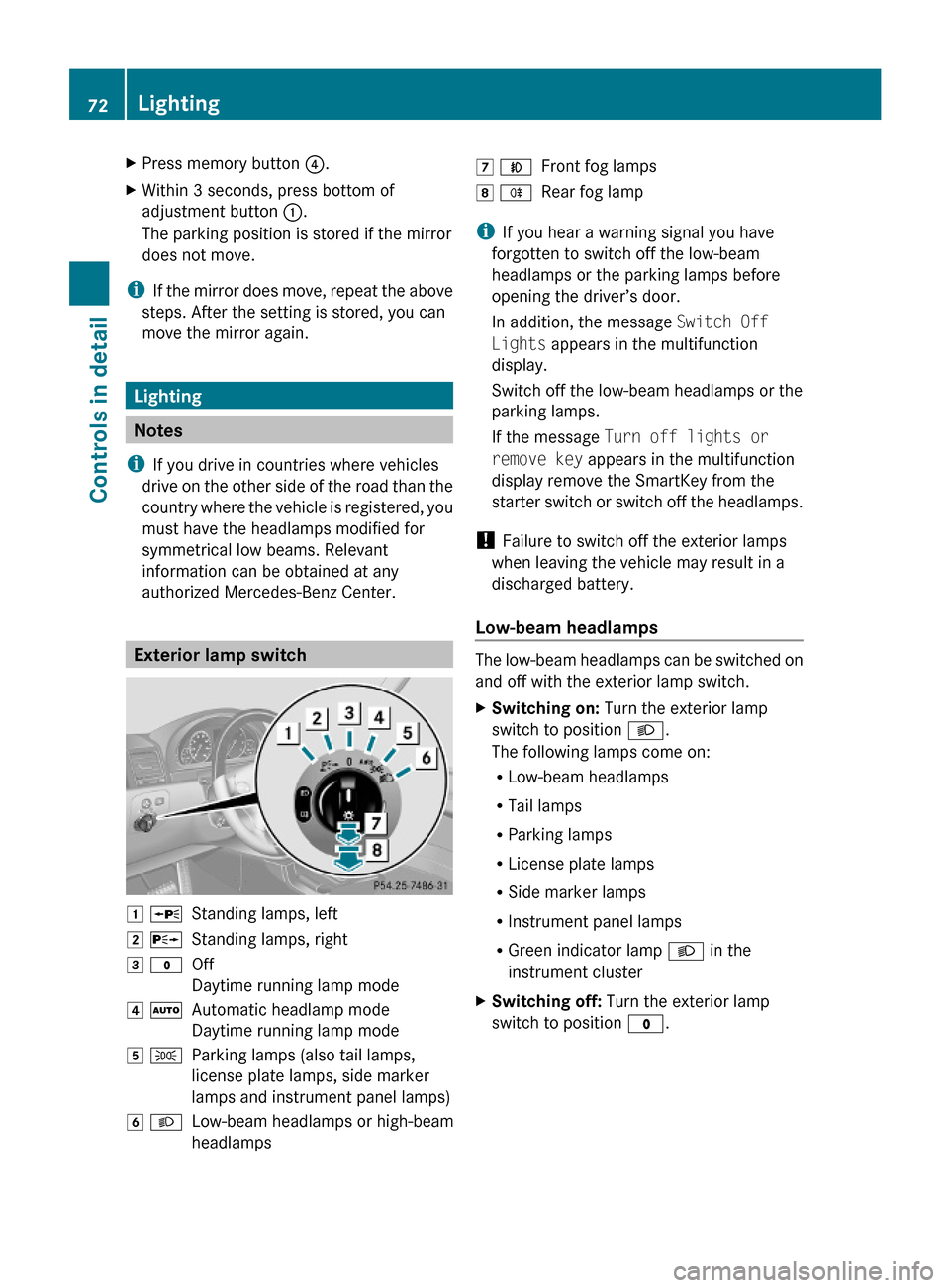
XPress memory button ?.XWithin 3 seconds, press bottom of
adjustment button :.
The parking position is stored if the mirror
does not move.
iIf the mirror does move, repeat the above
steps. After the setting is stored, you can
move the mirror again.
Lighting
Notes
iIf you drive in countries where vehicles
drive on the other side of the road than the
country where the vehicle is registered, you
must have the headlamps modified for
symmetrical low beams. Relevant
information can be obtained at any
authorized Mercedes-Benz Center.
Exterior lamp switch
1 WStanding lamps, left2 XStanding lamps, right3 $Off
Daytime running lamp mode
4 ÃAutomatic headlamp mode
Daytime running lamp mode
5 TParking lamps (also tail lamps,
license plate lamps, side marker
lamps and instrument panel lamps)
6 LLow-beam headlamps or high-beam
headlamps
7 NFront fog lamps8 RRear fog lamp
iIf you hear a warning signal you have
forgotten to switch off the low-beam
headlamps or the parking lamps before
opening the driver’s door.
In addition, the message Switch Off
Lights appears in the multifunction
display.
Switch off the low-beam headlamps or the
parking lamps.
If the message Turn off lights or
remove key appears in the multifunction
display remove the SmartKey from the
starter switch or switch off the headlamps.
! Failure to switch off the exterior lamps
when leaving the vehicle may result in a
discharged battery.
Low-beam headlamps
The low-beam headlamps can be switched on
and off with the exterior lamp switch.
XSwitching on: Turn the exterior lamp
switch to position L.
The following lamps come on:
RLow-beam headlamps
RTail lamps
RParking lamps
RLicense plate lamps
RSide marker lamps
RInstrument panel lamps
RGreen indicator lamp L in the
instrument cluster
XSwitching off: Turn the exterior lamp
switch to position $.
72LightingControls in detail
463_AKB; 2; 52, en-USd2ureepe,Version: 2.11.7.12008-12-02T10:52:11+01:00 - Seite 72
Page 90 of 264
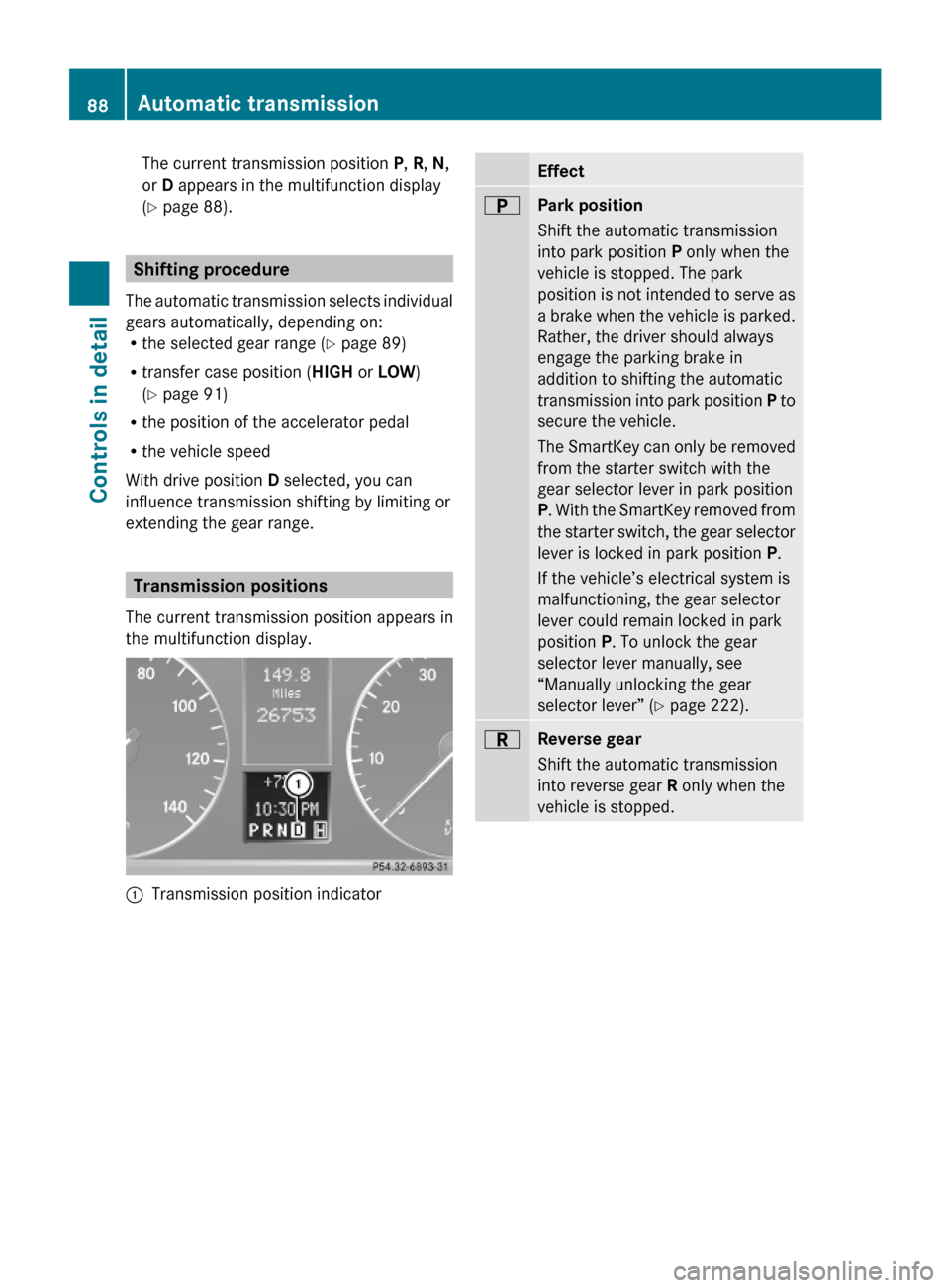
The current transmission position P, R, N,
or D appears in the multifunction display
(Y page 88).
Shifting procedure
The automatic transmission selects individual
gears automatically, depending on:Rthe selected gear range (Y page 89)
Rtransfer case position (HIGH or LOW)
(Y page 91)
Rthe position of the accelerator pedal
Rthe vehicle speed
With drive position D selected, you can
influence transmission shifting by limiting or
extending the gear range.
Transmission positions
The current transmission position appears in
the multifunction display.
:Transmission position indicator EffectBPark position
Shift the automatic transmission
into park position P only when the
vehicle is stopped. The park
position is not intended to serve as
a brake when the vehicle is parked.
Rather, the driver should always
engage the parking brake in
addition to shifting the automatic
transmission into park position P to
secure the vehicle.
The SmartKey can only be removed
from the starter switch with the
gear selector lever in park position
P. With the SmartKey removed from
the starter switch, the gear selector
lever is locked in park position P.
If the vehicle’s electrical system is
malfunctioning, the gear selector
lever could remain locked in park
position P. To unlock the gear
selector lever manually, see
“Manually unlocking the gear
selector lever” (Y page 222).
CReverse gear
Shift the automatic transmission
into reverse gear R only when the
vehicle is stopped.
88Automatic transmissionControls in detail
463_AKB; 2; 52, en-USd2ureepe,Version: 2.11.7.12008-12-02T10:52:11+01:00 - Seite 88
Page 91 of 264

EffectANeutral position
No power is transmitted from the
engine to the drive axle. When the
brakes are released, the vehicle can
be moved freely (pushed or towed).
To avoid damage to the
transmission, never shift the
automatic transmission into neutral
position N while driving.
Exceptions:
RIf the ESP® is deactivated or
malfunctioning, shift the
automatic transmission into
neutral position N if the vehicle is
in danger of skidding.
RShift the automatic transmission
into neutral position N if you have
to shift the transfer case.
! Coasting the vehicle, or driving
for any other reason with the
automatic transmission in neutral
position N can result in
transmission damage that is not
covered by the Mercedes-Benz
Limited Warranty.
7Drive position
The automatic transmission shifts
automatically. All forward gears are
available.
Driving tips
Kickdown
Use the kickdown when you want maximum
acceleration.
XDepress the accelerator pedal past the
point of resistance.
Depending on the engine speed the
automatic transmission shifts into a lower
gear.
Working on the vehicleGWarning!
When working on the vehicle, engage the
parking brake and shift the automatic
transmission into park position P. Otherwise
the vehicle could roll away which could result
in an accident and/or serious personal injury.
Gear ranges
With the automatic transmission in drive
position D, you can limit or extend the gear
range, see “One-touch gearshifting”
(Y page 90).
The current gear range appears in the
multifunction display.
:Gear range indicator
! If the transfer case is in off-road position
LOW, the automatic transmission will not
shift up automatically, even when the
engine has reached the speed limit for that
gear. There is a risk of damaging the
engine.
It is very important to make sure the
permissible engine speed is not exceeded.
Automatic transmission89Controls in detail463_AKB; 2; 52, en-USd2ureepe,Version: 2.11.7.12008-12-02T10:52:11+01:00 - Seite 89Z
Page 93 of 264
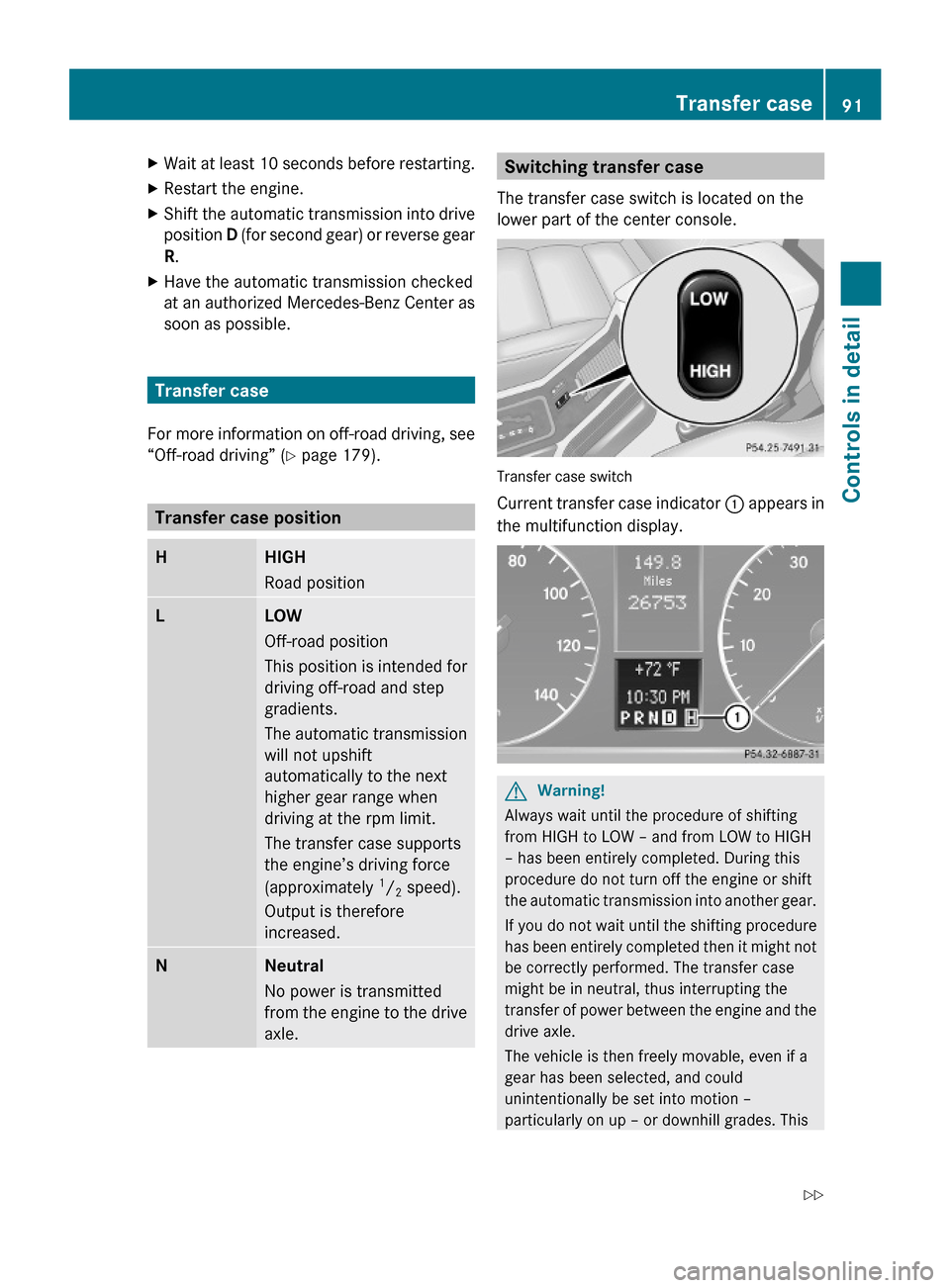
XWait at least 10 seconds before restarting.XRestart the engine.XShift the automatic transmission into drive
position D (for second gear) or reverse gear
R.
XHave the automatic transmission checked
at an authorized Mercedes-Benz Center as
soon as possible.
Transfer case
For more information on off-road driving, see
“Off-road driving” (Y page 179).
Transfer case position
HHIGH
Road position
LLOW
Off-road position
This position is intended for
driving off-road and step
gradients.
The automatic transmission
will not upshift
automatically to the next
higher gear range when
driving at the rpm limit.
The transfer case supports
the engine’s driving force
(approximately 1/2 speed).
Output is therefore
increased.
NNeutral
No power is transmitted
from the engine to the drive
axle.
Switching transfer case
The transfer case switch is located on the
lower part of the center console.
Transfer case switch
Current transfer case indicator : appears in
the multifunction display.
GWarning!
Always wait until the procedure of shifting
from HIGH to LOW – and from LOW to HIGH
– has been entirely completed. During this
procedure do not turn off the engine or shift
the automatic transmission into another gear.
If you do not wait until the shifting procedure
has been entirely completed then it might not
be correctly performed. The transfer case
might be in neutral, thus interrupting the
transfer of power between the engine and the
drive axle.
The vehicle is then freely movable, even if a
gear has been selected, and could
unintentionally be set into motion –
particularly on up – or downhill grades. This
Transfer case91Controls in detail463_AKB; 2; 52, en-USd2ureepe,Version: 2.11.7.12008-12-02T10:52:11+01:00 - Seite 91Z
Page 96 of 264
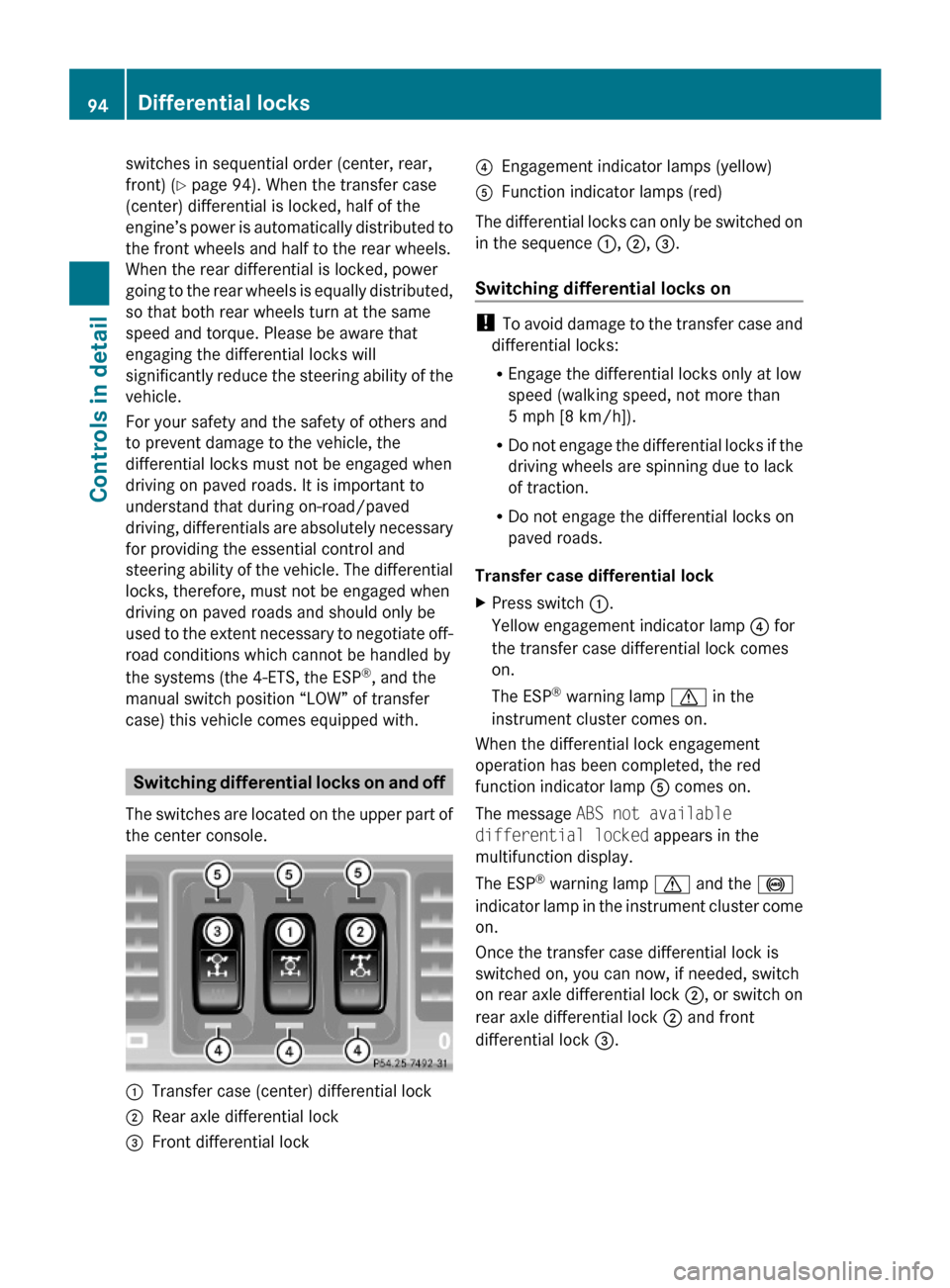
switches in sequential order (center, rear,
front) (Y page 94). When the transfer case
(center) differential is locked, half of the
engine’s power is automatically distributed to
the front wheels and half to the rear wheels.
When the rear differential is locked, power
going to the rear wheels is equally distributed,
so that both rear wheels turn at the same
speed and torque. Please be aware that
engaging the differential locks will
significantly reduce the steering ability of the
vehicle.
For your safety and the safety of others and
to prevent damage to the vehicle, the
differential locks must not be engaged when
driving on paved roads. It is important to
understand that during on-road/paved
driving, differentials are absolutely necessary
for providing the essential control and
steering ability of the vehicle. The differential
locks, therefore, must not be engaged when
driving on paved roads and should only be
used to the extent necessary to negotiate off-
road conditions which cannot be handled by
the systems (the 4-ETS, the ESP®, and the
manual switch position “LOW” of transfer
case) this vehicle comes equipped with.
Switching differential locks on and off
The switches are located on the upper part of
the center console.
:Transfer case (center) differential lock;Rear axle differential lock=Front differential lock?Engagement indicator lamps (yellow)AFunction indicator lamps (red)
The differential locks can only be switched on
in the sequence :, ;, =.
Switching differential locks on
! To avoid damage to the transfer case and
differential locks:
REngage the differential locks only at low
speed (walking speed, not more than
5 mph [8 km/h]).
RDo not engage the differential locks if the
driving wheels are spinning due to lack
of traction.
RDo not engage the differential locks on
paved roads.
Transfer case differential lock
XPress switch :.
Yellow engagement indicator lamp ? for
the transfer case differential lock comes
on.
The ESP® warning lamp d in the
instrument cluster comes on.
When the differential lock engagement
operation has been completed, the red
function indicator lamp A comes on.
The message ABS not available
differential locked appears in the
multifunction display.
The ESP® warning lamp d and the !
indicator lamp in the instrument cluster come
on.
Once the transfer case differential lock is
switched on, you can now, if needed, switch
on rear axle differential lock ;, or switch on
rear axle differential lock ; and front
differential lock =.
94Differential locksControls in detail
463_AKB; 2; 52, en-USd2ureepe,Version: 2.11.7.12008-12-02T10:52:11+01:00 - Seite 94
Page 97 of 264
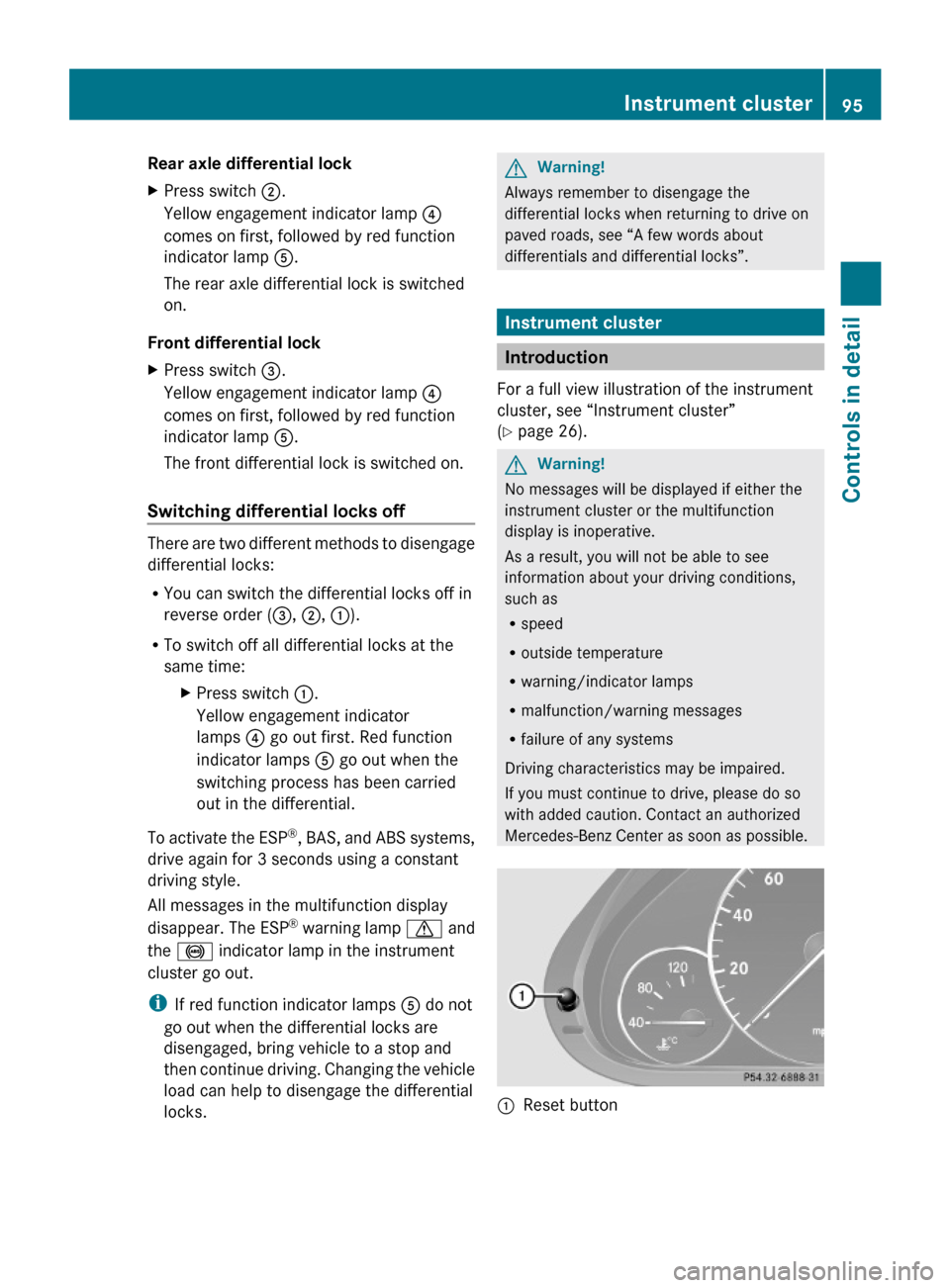
Rear axle differential lockXPress switch ;.
Yellow engagement indicator lamp ?
comes on first, followed by red function
indicator lamp A.
The rear axle differential lock is switched
on.
Front differential lock
XPress switch =.
Yellow engagement indicator lamp ?
comes on first, followed by red function
indicator lamp A.
The front differential lock is switched on.
Switching differential locks off
There are two different methods to disengage
differential locks:
RYou can switch the differential locks off in
reverse order (=, ;, :).
RTo switch off all differential locks at the
same time:
XPress switch :.
Yellow engagement indicator
lamps ? go out first. Red function
indicator lamps A go out when the
switching process has been carried
out in the differential.
To activate the ESP®, BAS, and ABS systems,
drive again for 3 seconds using a constant
driving style.
All messages in the multifunction display
disappear. The ESP® warning lamp d and
the ! indicator lamp in the instrument
cluster go out.
iIf red function indicator lamps A do not
go out when the differential locks are
disengaged, bring vehicle to a stop and
then continue driving. Changing the vehicle
load can help to disengage the differential
locks.
GWarning!
Always remember to disengage the
differential locks when returning to drive on
paved roads, see “A few words about
differentials and differential locks”.
Instrument cluster
Introduction
For a full view illustration of the instrument
cluster, see “Instrument cluster”
(Y page 26).
GWarning!
No messages will be displayed if either the
instrument cluster or the multifunction
display is inoperative.
As a result, you will not be able to see
information about your driving conditions,
such as
Rspeed
Routside temperature
Rwarning/indicator lamps
Rmalfunction/warning messages
Rfailure of any systems
Driving characteristics may be impaired.
If you must continue to drive, please do so
with added caution. Contact an authorized
Mercedes-Benz Center as soon as possible.
:Reset button Instrument cluster95Controls in detail463_AKB; 2; 52, en-USd2ureepe,Version: 2.11.7.12008-12-02T10:52:11+01:00 - Seite 95Z
Page 99 of 264

Control system
Introduction
The control system is activated as soon as the
starter switch is in position 1 (Y page 62).
The control system enables you to call up
information about your vehicle and to change
vehicle settings.
For example, you can use the control system
to find out when your vehicle is next due for
maintenance service, to set the language for
messages in the instrument cluster display,
and much more.
GWarning!
A driver’s attention to the road and traffic
conditions must always be his/her primary
focus when driving.
For your safety and the safety of others,
selecting features through the multifunction
steering wheel should only be done by the
driver when traffic and road conditions permit
it to be done safely.
Bear in mind that at a speed of just 30 mph
(approximately 50 km/h), your vehicle is
covering a distance of 44 feet (approximately
14 m) every second.
The control system relays information to the
multifunction display.
Multifunction steering wheel
The displays in the multifunction display and
the settings in the control system are
controlled by the buttons on the multifunction
steering wheel.
:Multifunction display;Press buttonW
X
to select submenus in the
Settings menu
to set values
to set the volume
=Press button6to answer a call
to dial2
to redial
~to end a call
to reject an incoming call
?Press buttonV
U
to select next or previous menu2Function only available in telephone menu.Control system97Controls in detail463_AKB; 2; 52, en-USd2ureepe,Version: 2.11.7.12008-12-02T10:52:11+01:00 - Seite 97Z